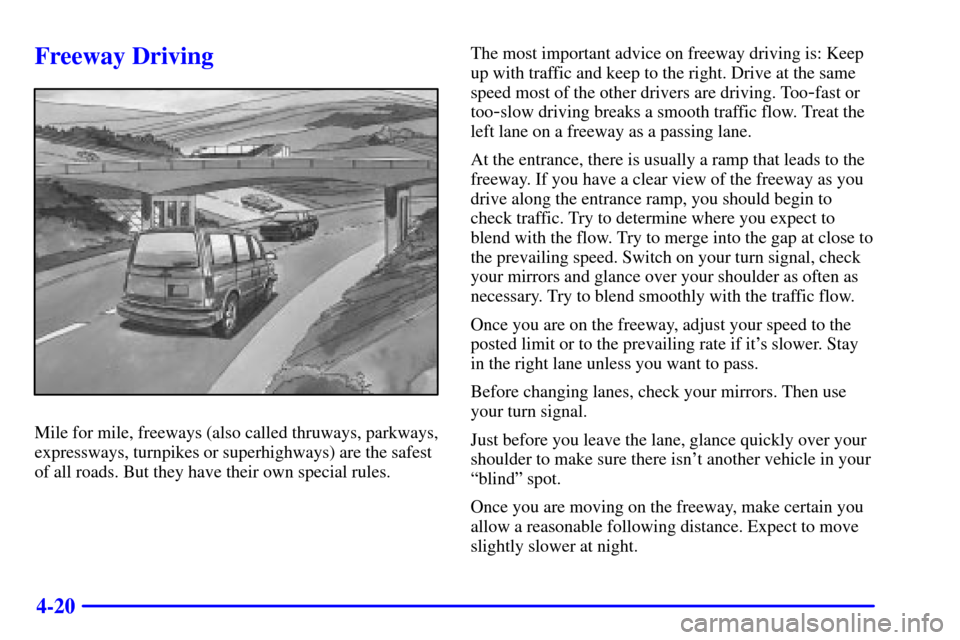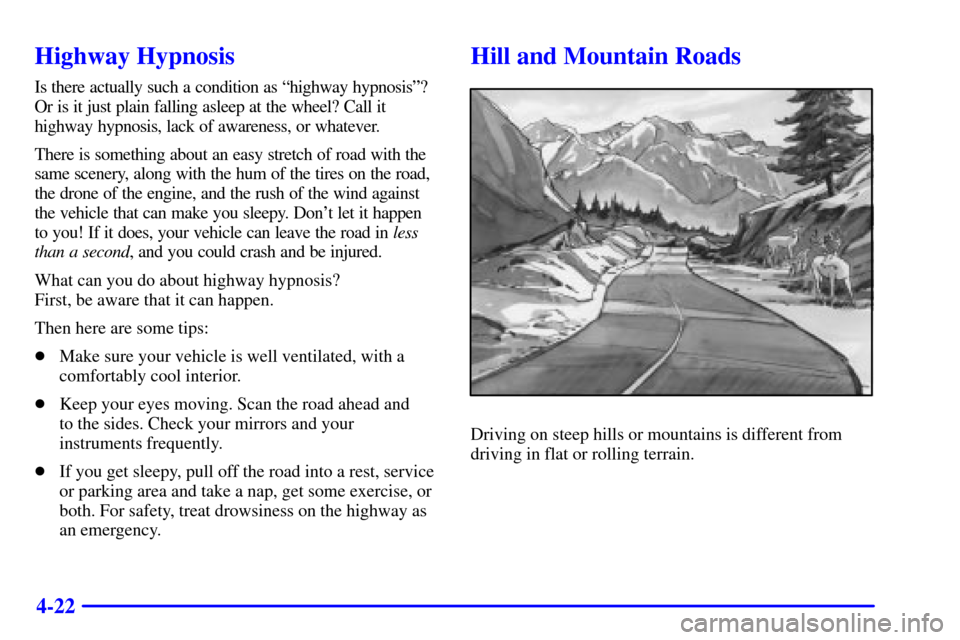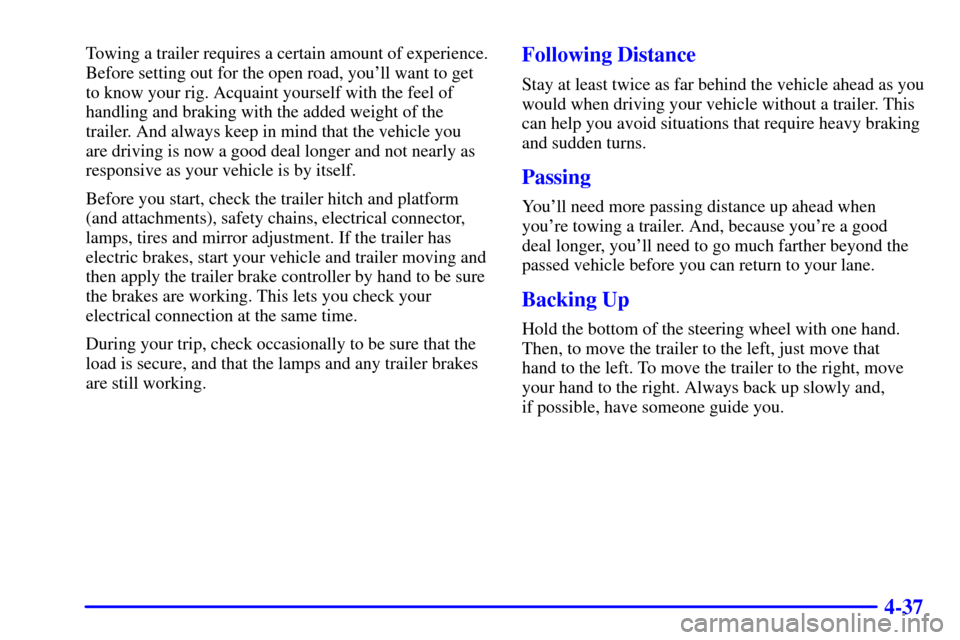Page 200 of 391

4-20
Freeway Driving
Mile for mile, freeways (also called thruways, parkways,
expressways, turnpikes or superhighways) are the safest
of all roads. But they have their own special rules.The most important advice on freeway driving is: Keep
up with traffic and keep to the right. Drive at the same
speed most of the other drivers are driving. Too
-fast or
too
-slow driving breaks a smooth traffic flow. Treat the
left lane on a freeway as a passing lane.
At the entrance, there is usually a ramp that leads to the
freeway. If you have a clear view of the freeway as you
drive along the entrance ramp, you should begin to
check traffic. Try to determine where you expect to
blend with the flow. Try to merge into the gap at close to
the prevailing speed. Switch on your turn signal, check
your mirrors and glance over your shoulder as often as
necessary. Try to blend smoothly with the traffic flow.
Once you are on the freeway, adjust your speed to the
posted limit or to the prevailing rate if it's slower. Stay
in the right lane unless you want to pass.
Before changing lanes, check your mirrors. Then use
your turn signal.
Just before you leave the lane, glance quickly over your
shoulder to make sure there isn't another vehicle in your
ªblindº spot.
Once you are moving on the freeway, make certain you
allow a reasonable following distance. Expect to move
slightly slower at night.
Page 202 of 391

4-22
Highway Hypnosis
Is there actually such a condition as ªhighway hypnosisº?
Or is it just plain falling asleep at the wheel? Call it
highway hypnosis, lack of awareness, or whatever.
There is something about an easy stretch of road with the
same scenery, along with the hum of the tires on the road,
the drone of the engine, and the rush of the wind against
the vehicle that can make you sleepy. Don't let it happen
to you! If it does, your vehicle can leave the road in less
than a second, and you could crash and be injured.
What can you do about highway hypnosis?
First, be aware that it can happen.
Then here are some tips:
�Make sure your vehicle is well ventilated, with a
comfortably cool interior.
�Keep your eyes moving. Scan the road ahead and
to the sides. Check your mirrors and your
instruments frequently.
�If you get sleepy, pull off the road into a rest, service
or parking area and take a nap, get some exercise, or
both. For safety, treat drowsiness on the highway as
an emergency.
Hill and Mountain Roads
Driving on steep hills or mountains is different from
driving in flat or rolling terrain.
Page 217 of 391

4-37
Towing a trailer requires a certain amount of experience.
Before setting out for the open road, you'll want to get
to know your rig. Acquaint yourself with the feel of
handling and braking with the added weight of the
trailer. And always keep in mind that the vehicle you
are driving is now a good deal longer and not nearly as
responsive as your vehicle is by itself.
Before you start, check the trailer hitch and platform
(and attachments), safety chains, electrical connector,
lamps, tires and mirror adjustment. If the trailer has
electric brakes, start your vehicle and trailer moving and
then apply the trailer brake controller by hand to be sure
the brakes are working. This lets you check your
electrical connection at the same time.
During your trip, check occasionally to be sure that the
load is secure, and that the lamps and any trailer brakes
are still working.Following Distance
Stay at least twice as far behind the vehicle ahead as you
would when driving your vehicle without a trailer. This
can help you avoid situations that require heavy braking
and sudden turns.
Passing
You'll need more passing distance up ahead when
you're towing a trailer. And, because you're a good
deal longer, you'll need to go much farther beyond the
passed vehicle before you can return to your lane.
Backing Up
Hold the bottom of the steering wheel with one hand.
Then, to move the trailer to the left, just move that
hand to the left. To move the trailer to the right, move
your hand to the right. Always back up slowly and,
if possible, have someone guide you.
Page 317 of 391
6-62
Instrument Panel Fuse Block
The fuse block is on the lower portion of the instrument
panel on the driver's side.Fuse/Circuit
BreakerUsage
1 Stop/Turn/Hazard Lamps,
CHMSL, ABS
2 Radio ACCY, RR Seat
Audio Controls
3 Courtesy Lamps, Glove Box
Lamp, Dome Reading Lamps,
Vanity Mirror Lamps,
Courtesy Lamps
Page 318 of 391

6-63
Fuse/Circuit
BreakerUsage
4 DRL Relay, Instrument
Panel Cluster
5 Rear Defogger
6 Cruise Module, TBC Module,
Instrument Panel Cluster,
Cruise Control Switch,
Electrochromic Mirror
7 Power Outlets, DLC,
Subwoofer Amplifier
8 Crank Circuit Fuse, Park/Neutral
Switch, Starter Enable Relay
9 License Plate Lamp, Taillamps,
Parking Lamps, Ashtray Lamp,
Panel Lights, Trailer Taillamps,
Front and Rear Sidemarker
Lamps, Door Switch Illumination,
Headlamp Switch Illumination,
Rear Seat Audio Illumination,
TBC Module
10 Air Bag System
11 Not UsedFuse/Circuit
BreakerUsage
12 L, M1, M2 Blower Motor, Rear
A/C Relay Coil, Front Cont.
Temp. Door Motor, HI Blower
Relay, Defogger Timer Coil
13 Cigarette Lighter, Door Lock
Switches, Dutch Door
Release Module
14 Cluster Illum, HVAC Controls,
Chime Module, Radio
Illumination, Rear Heat Switch
Illumination, Rear Wiper/Washer
Switch Illumination, Rear Liftgate
Switch Illumination, Remote
Cassette Illumination, O/H
Console, TBC Illumination
15 TBC Module, Headlamp Relay
16 Front Turn Signals, Rear Turn
Signals, Trailer Turn Signals,
Back
-Up Lamps, BTSI Solenoid
17 Front Wipers, Front Washer Pump
18 VCM
-Ign 3, VCM-Brake, Cruise
Stepper Motor Signal,
ATC Module
Page 319 of 391
6-64
Fuse/Circuit
BreakerUsage
19 Instrument Panel Radio:
ATC (Main Feed),
2000 Series (Standby)
20 PRNDL/ Odometer, TCC Enable
and PWM Solenoid, Shift A and
Shift B Solenoids, 3
-2 Downshift
Solenoid, Instrument Panel
Cluster, VCM Module
21 Pwr Adj Mirrors
22 Not Used
23 Rear Wiper, Rear Washer Pump
24 Not Used
A (Circuit Breaker) Power Door
Lock Relay, 6
-Way Power Seats
B (Circuit Breaker) Power WindowsUnderhood Electrical CenterThe underhood electrical center is located toward the
rear of the engine compartment on the driver's side.
Lift the hood and open the cover to gain access to this
fuse block.
Page 321 of 391

6-66
Fuse/Circuit
Breaker Usage
ECM
-B Fuel Pump Relay and Motor,
VCM, Oil Pressure
Switch/Sender
HORN Horn Relay and Horn
A/C COMP A/C Enable Relay
and Compressor
RR HTR/AC Rear Heater and A/C
ATC Active Transfer Case
FRT HVAC Front Heater and A/C
ENG
-I Oxygen Sensors, Camshaft
Position Sensor, Mass Air Flow
Sensor, Evaporative Emission
Canister Vent Solenoid
IGN
-E A/C Enable Relay Coil
ECM
-I Fuel Injectors 1-6, Crankshaft
Position Sensor, VCM, Coil
Driver Module (EST),
Ignition CoilFuse/Circuit
Breaker Usage
RH HDLMP Right Headlamp
LH Headlamp Left Headlamp
DIODE
-A/C Coil A/C
LIGHTING Courtesy Fuse, Pwr. Adj.
Mirrors Fuse, TBC
-Battery Fuse
BATT Power ACCY CB, Stop/Hazard
Fuse, Auxiliary Power Fuse,
Cigarette Lighter Fuse,
Radio Battery Fuse
IGN A Starter Relay, Ignition Switch
IGN B Ignition Switch
ABS Electronic Brake
Control Module
RAP Radio Accy, Power Windows
HTD MIR/RR
DEFOGRear Window Defogger,
HVAC Control Head
*A fuse puller is included in the underhood electrical
center. You will also find spare fuses.